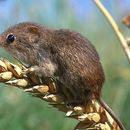Biology
provided by Arkive
Harvest mice have bouts of activity throughout the 24-hour period, but they tend to be more active during the evening and night (5). In summer they become increasingly nocturnal, whereas during the winter they are more active in the day (5). They are adept climbers, and typically feed up in the stalk-zone of long reeds and grasses (2). Depending on the time of year, harvest mice feed on grass seeds, cereals, berries, insects, fruits and the young shoots of grasses (5).
The nests of harvest mice are the most complex structures made by any British mammal (3). These spherical nests, constructed by pregnant females, are made of woven grasses and may measure up to 10cm in diameter (2). They are located up to 1 meter above ground in grasses or reeds (2). Breeding takes place between May and October, and when the weather conditions are suitable, they may even continue to breed until December (5). Between 3 and 7 litters are produced a year, each consisting of 1-8 young (5).Births usually occur at night. The female suckles the young until they reach around 9 days of age, at which time they are given their first solid food in the form of chewed seeds (3). When the young reach around 18 days of age, the female may become aggressive towards them, ejecting them from the nest. Upon reaching 6 weeks of age, the young will be able to breed (5). Very few harvest mice live beyond 6 months, although the maximum recorded lifespan is 18 months (5). Main causes of mortality are cold or wet weather, sudden frosts (5), and predation by weasels, stoats, foxes, cats, owls and crows (2).
Conservation
provided by Arkive
This species is not currently legally protected in the UK. Chester Zoo is coordinating a captive breeding and reintroduction programme in the county of Cheshire, in order to reinforce populations in that area. This well-managed captive population provides a safety net for Britain's wild harvest mice, and has enabled successful husbandry and captive breeding methods to be devised. Should the species become threatened in the future, these techniques will be essential in maintaining the species, and the captive population will provide a source of reintroductions to the wild (6).
Description
provided by Arkive
The diminutive harvest mouse is the smallest rodent in Europe, weighing up to just 6g (4). It is easily identified, with its blunt nose (2), short, rounded hairy ears and golden-brown fur (4). Juveniles are grey brown in colour (4). This species is the only British animal to posses a prehensile tail, which is used as a fifth limb; this characteristic is a sure-fire way of identifying a harvest mouse (4).
Habitat
provided by Arkive
This species seems to prefer dry areas, and so its distribution may be affected by summer rainfall (5). They inhabit dry reedbeds, patches of bramble, hay meadows, and some crop fields, particularly where there are winter refuges such as grassy banks (5). They may also occur in hedgerows, field edges and other linear habitats, as well as wasteland in urban sites (5).
Range
provided by Arkive
In Great Britain, harvest mice are restricted to southern parts of England and coastal areas of Wales (5). Outside of this core range there are a number of scattered populations, which are the result of introductions (5).
Status
provided by Arkive
Classified as Lower Risk/ near threatened (LR/nt) by the IUCN Red List (3).
Threats
provided by Arkive
The harvest mouse is susceptible to changes in land use; combine harvesting, burning of stubbles, ploughing, hedge trimming or removal and the use of pesticides all impact on this species (5). Climate change and flooding are also likely to pose a threat (5).

